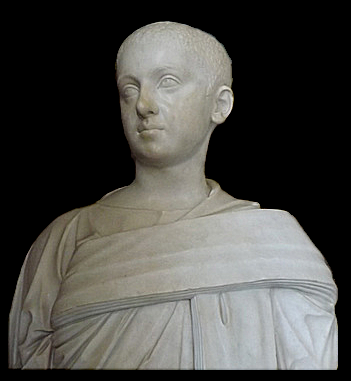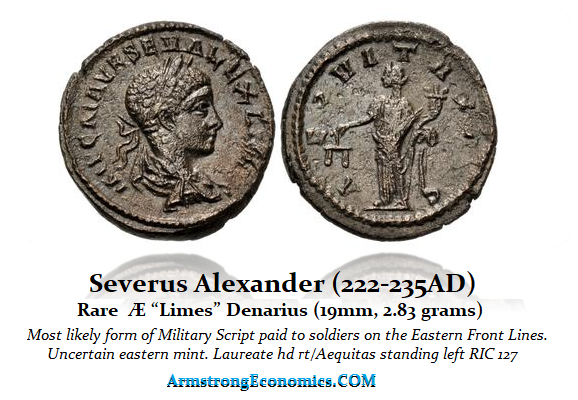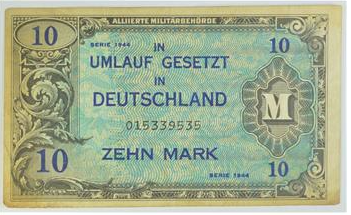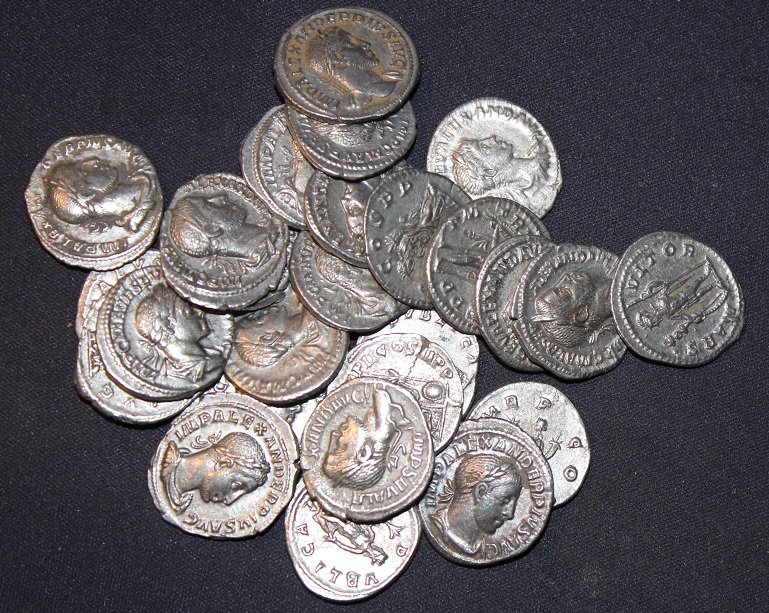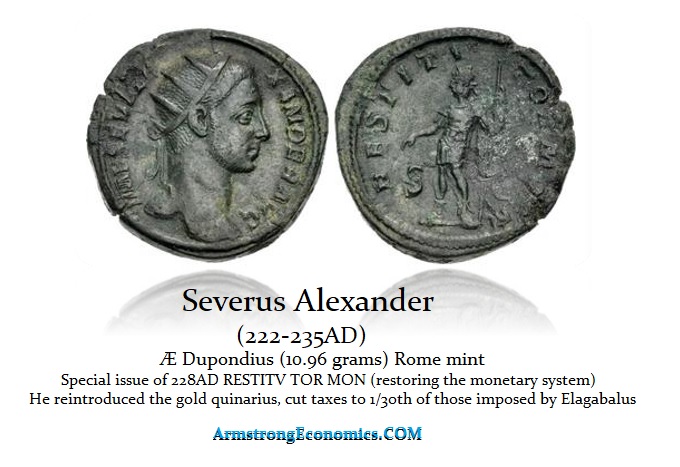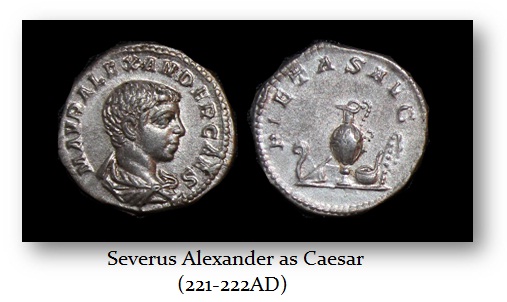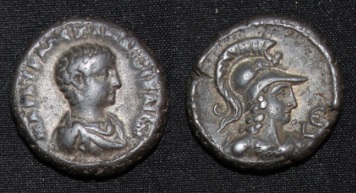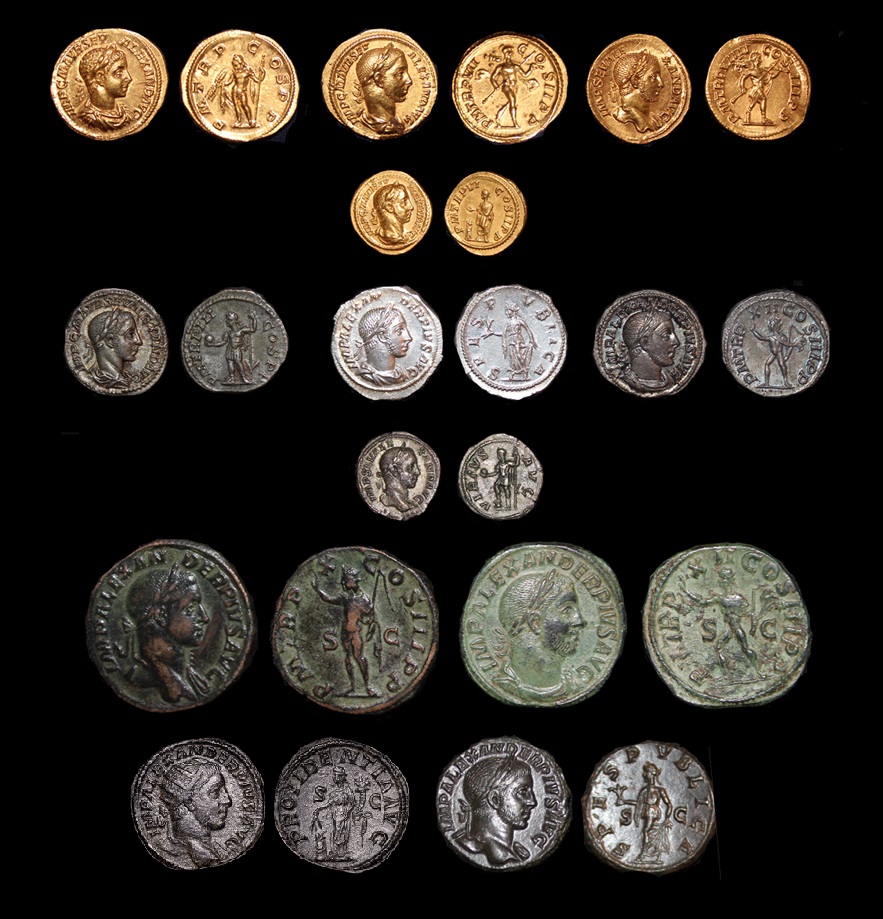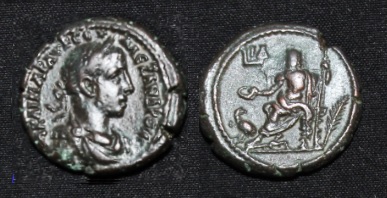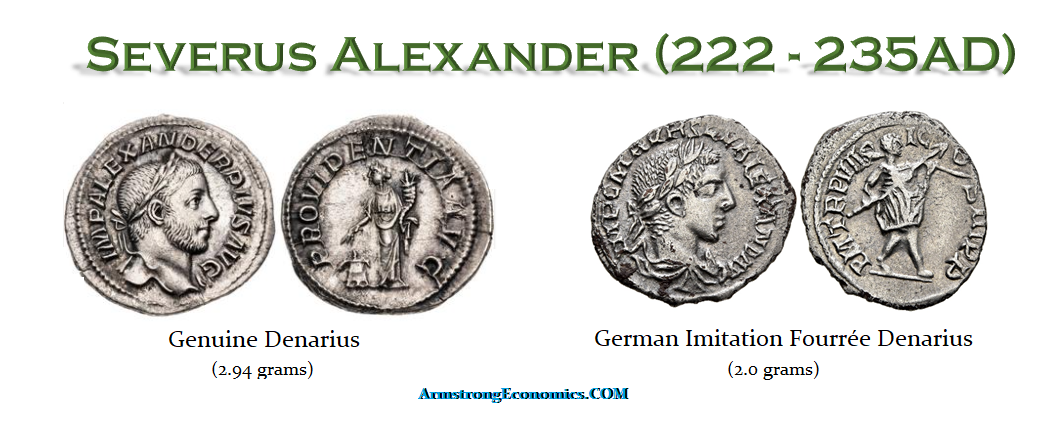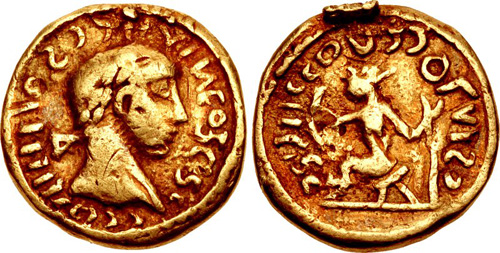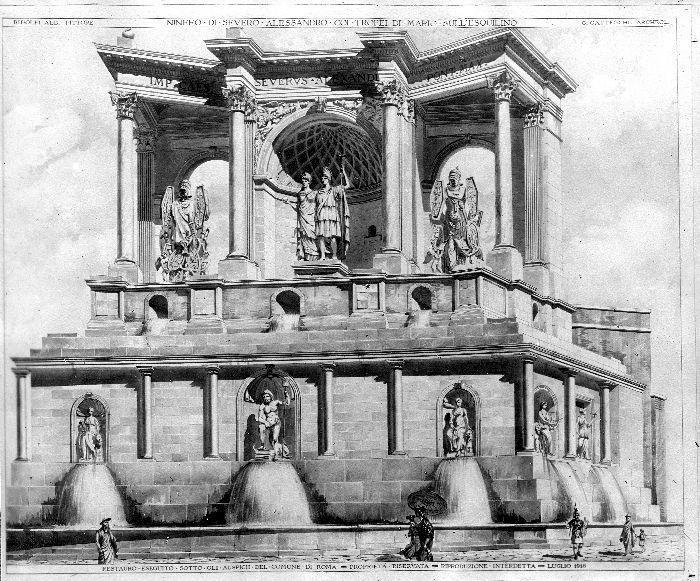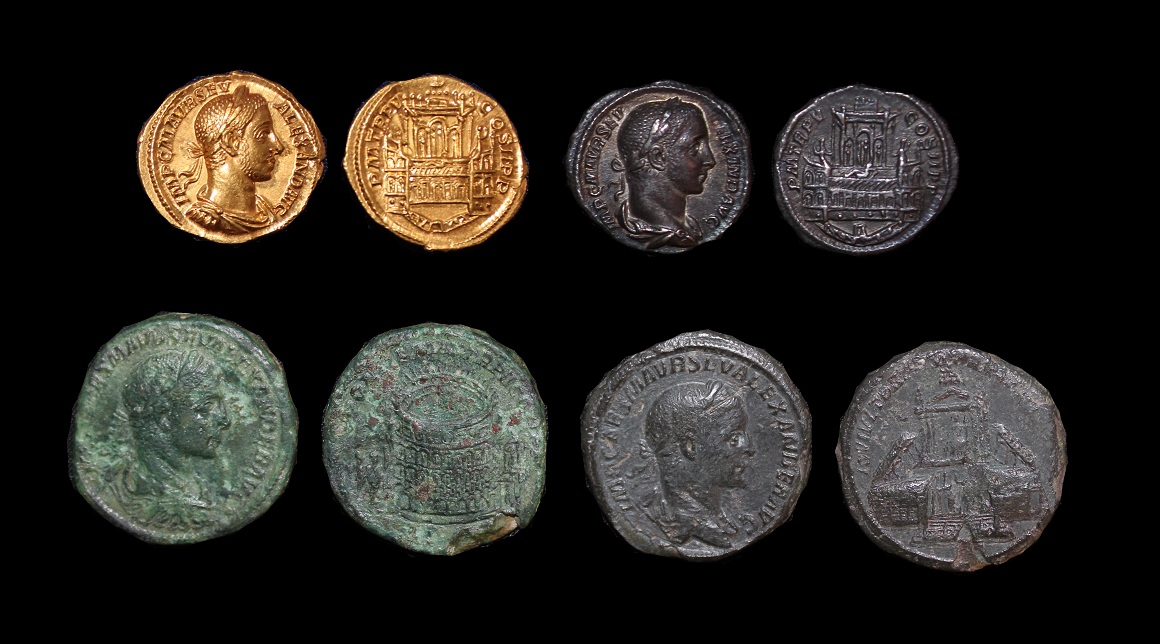Severus Alexander
222-235 AD
Marcus Aurelius Severus Alexander was originally named Alexianus. He was born about 208 AD. Alexander was the son of Julia Mamaea and Gessius Marcianus. At the insistence of his grandmother, Julia Maesa, Alexander was adopted by his cousin and was adopted by his cousin Elagabalus in 221 AD, making him the legal heir to the throne. Simultaneously, Alexander was raised to the rank of Caesar. After the murder of Elagabalus, Alexander was acknowledged as Emperor by the Praetorian guards at the insistence of his grandmother, Julia Maesa. The Senate confirmed his position the following day.
Under the rule of Severus Alexander, the empire seemed to recover. The economic condition of the state was greatly improved. The above illustration is a bronze sestertius announcing the restoration of the Colosseum as one of his public work projects. However, it was during his reign that the first movements of a new enemy were to begin – the Goths. Over the next 50 years, the Goths would devastate much of the Roman Empire, driving deep into the Eastern provinces.
 Herodian tells us that Alexander was entirely dominated by his mother, Julia Mamaea. Like many women from the Severian dynasty, a dominating personality seems to be a strong trait. Herodian remarked that Alexander “did exactly as he was told. This was the one thing for which he can be faulted; that he obeyed his mother in matters of which he disapproved because he was over-mild and showed greater respect to her than he should have done.” Indeed, this problem of being ruled by his mother created much resentment among the army – a factor that no doubt cast his own fate.
Herodian tells us that Alexander was entirely dominated by his mother, Julia Mamaea. Like many women from the Severian dynasty, a dominating personality seems to be a strong trait. Herodian remarked that Alexander “did exactly as he was told. This was the one thing for which he can be faulted; that he obeyed his mother in matters of which he disapproved because he was over-mild and showed greater respect to her than he should have done.” Indeed, this problem of being ruled by his mother created much resentment among the army – a factor that no doubt cast his own fate.
While the first nine years of Alexander’s reign were peaceful and free from foreign wars, that situation changed in 232 AD. Alexander was forced to take to the field against the Sassanid Ardashir, who had recently overthrown the Arsacid kingdom of Parthia. Ardashir began to threaten Syria and Cappadocia, which are key northern African territories. Alexander’s campaign against Ardashir met with only limited success. Alexander was soon forced to return to the West, where disturbances on the German frontier required his presence. Before the fighting actually began, the soldiers rebelled because Alexander tried to buy off the invaders. The troops proclaimed their commander, Maximinus, Emperor. Alexander and Julia Mamaea were both murdered at their camp near Mainz on March 22nd, 235 AD.
The official name of the landmark of Rome was Amphitheatrum Flavium, named after Vespasian (69-79AD) dynasty. The common name Colosseum was the street name attributed to it, not for its size, but because the theater was built next to where the enormous statue of the Roman emperor, Nero (b 37; 54–68 AD), once stood known as the Colossus Neronis. This statue was often referred to as the “Colossus of Nero” and stood at an enormous height made entirely of bronze. According to Pliny the Elder, the statue reached 106.5 Roman Feet (30.3 m) in height, though other sources claim it was as much as 37 m.
 This construction of the Colosseum was also political, for the popular belief that Nero had set fire to Rome so he could build his palace. The unpopular act of Nero clearly justified the redevelopment of that area, and this is where the Colosseum stands today. This enormous statue of Emperor Nero was created in the vestibule of his Domus Aurea, the imperial villa complex he built, which spanned a large area from the north side of the Palatine Hill across the Velian ridge to the Esquiline Hill.
This construction of the Colosseum was also political, for the popular belief that Nero had set fire to Rome so he could build his palace. The unpopular act of Nero clearly justified the redevelopment of that area, and this is where the Colosseum stands today. This enormous statue of Emperor Nero was created in the vestibule of his Domus Aurea, the imperial villa complex he built, which spanned a large area from the north side of the Palatine Hill across the Velian ridge to the Esquiline Hill.
The statue was placed just outside the main palace entrance at the terminus of the Via Appia in a large atrium of porticoes that divided the city from the private villa. The Greek architect Zenodorus designed the statue and began construction between 64AD and 68AD.
Shortly after Nero’s death in 68AD, followed by the Civil War, the victor Vespasian, in order to gather the support from the people for the continuation of the Imperial form of government at the end of the Julio-Claudian Dynasty, reclaimed the area and began the construction of the Colosseum and modified Colossus of Nero. The statue was eventually moved to a spot outside the Flavian Amphitheatre, and Vespasian added a sun-ray crown and renamed it Colossus Solis, after the Roman sun god Sol. Hence, the statue of Sol Invictus was so popular that the feast day of Sol was December 25th and was thus adopted by the Catholic Church for Christmas. Because it was a traditional holiday, people soon forgot why they had the day off.
The Colossus of Nero was last mentioned during the 4th century AD. Around 128, Emperor Hadrian ordered the statue moved from the Domus Aurea to just northwest of the Colosseum (Amphitheatrum Flavianum) in order to create space for the Temple of Venus and Roma. It was moved by the architect Decrianus with the use of 24 elephants. Emperor Commodus converted it into a statue of himself as Hercules by replacing the head, but after his death, it was restored, and so it remained.
 The fate of the Colossus of Nero is not certain. It was last mentioned in antiquity in the Chronography of 354 AD and Calendar of 354 AD. It was a 4th-century illuminated manuscript known to have been produced in 354 AD for a wealthy Roman Christian named Valentinus. Today, nothing remains of the Colossus of Nero save for the foundations of the pedestal at its second location near the Colosseum. It was possibly destroyed during the Sack of Rome in 410AD, for it surely would have been taken by the second sacking of Rome in 455AD carried out by the Vandals. They stripped copper from the roofs of numerous temples. Perhaps it was toppled in one of a series of fifth-century earthquakes, and its metal was scavenged during those hard economic times. There is a remote possibility that the statue was still standing during the Middle Ages since it is preserved in a medieval poem that says: As long as the Colossus stands, Rome will stand; when the Colossus falls, Rome will also fall.
The fate of the Colossus of Nero is not certain. It was last mentioned in antiquity in the Chronography of 354 AD and Calendar of 354 AD. It was a 4th-century illuminated manuscript known to have been produced in 354 AD for a wealthy Roman Christian named Valentinus. Today, nothing remains of the Colossus of Nero save for the foundations of the pedestal at its second location near the Colosseum. It was possibly destroyed during the Sack of Rome in 410AD, for it surely would have been taken by the second sacking of Rome in 455AD carried out by the Vandals. They stripped copper from the roofs of numerous temples. Perhaps it was toppled in one of a series of fifth-century earthquakes, and its metal was scavenged during those hard economic times. There is a remote possibility that the statue was still standing during the Middle Ages since it is preserved in a medieval poem that says: As long as the Colossus stands, Rome will stand; when the Colossus falls, Rome will also fall.
Nevertheless, in essence, the Colosseum got its name from the Colossus of Nero, and its construction was inaugurated by Vespasian’s son, Titus, in 80 AD and completed during the reign of his brother Domitian. The Colosseum was one of the most remarkable Roman structures to survive to this day, which was designed to seat 50,000 spectators. It had around eighty entrances to speed the attending crowds through — whether they were departing or arriving. Its construction is surprisingly “modern” in its utilization of different combinations of types of construction and materials: concrete for the foundations, travertine marble for the piers and arcades, tufa (a soft and easily worked volcanic rock) as infill between piers and walls of the lower two levels, and finally brick-faced concrete being used for the upper levels as well as for most of the vaults.
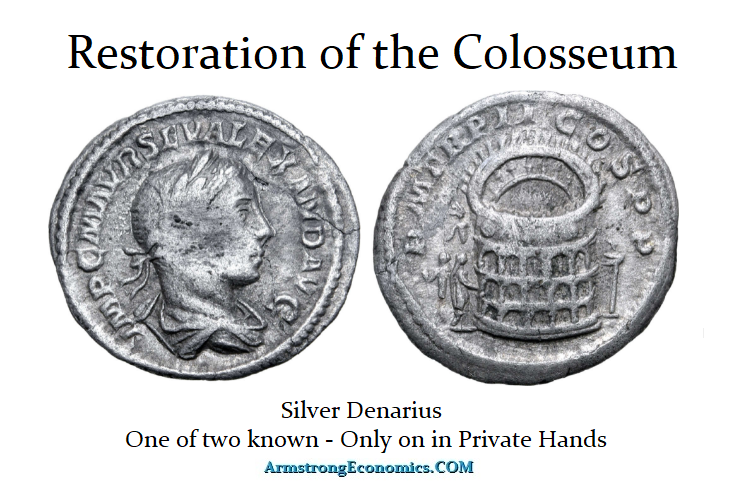 In 217 AD, early in the reign of Macrinus, the building was struck by lightning and badly damaged. (This was seen as a very ill omen for the tenure of the new emperor, who had replaced the recently assassinated Caracalla and whose death he was intimately involved in.) By 218 AD, the Severan dynasty was once more on the throne, in the guise of Elagabalus, and repairs to the Colosseum had begun. Work continued under Severus Alexander so that by 223 AD, the building was sufficiently restored to be used once more (work on the structure would continue for well over another decade, to be finished during the reign of Gordian III, who celebrated its completion with a small issue of medallions). The cost of repairing the Colosseum was significant for in 230AD. Emperor Severus Alexander placed a tax on pimps and both male and female prostitutes, with the stipulation that the income thus raised go not into the public treasury but towards the cost of restoring the Colosseum. (Imperial Lives, Severus Alexander 24.3).
In 217 AD, early in the reign of Macrinus, the building was struck by lightning and badly damaged. (This was seen as a very ill omen for the tenure of the new emperor, who had replaced the recently assassinated Caracalla and whose death he was intimately involved in.) By 218 AD, the Severan dynasty was once more on the throne, in the guise of Elagabalus, and repairs to the Colosseum had begun. Work continued under Severus Alexander so that by 223 AD, the building was sufficiently restored to be used once more (work on the structure would continue for well over another decade, to be finished during the reign of Gordian III, who celebrated its completion with a small issue of medallions). The cost of repairing the Colosseum was significant for in 230AD. Emperor Severus Alexander placed a tax on pimps and both male and female prostitutes, with the stipulation that the income thus raised go not into the public treasury but towards the cost of restoring the Colosseum. (Imperial Lives, Severus Alexander 24.3).
In honor of the Colosseum‘s reopening, Severus Alexander struck a very small issue of commemorative coins: a number of bronze sestertii and asses, a small issue of a silver denarius of which only two are known, and also a small issue of gold aurei, of which two are known.
ROMAN MILITARY SCRIPT
Limes denarius (Lim-ace), or coins of the borders, were bonze versions of silver denarii struck from official dies. They may be another example of coins of necessity issued because of a shortage of silver in the border regions. It has also been suggested that they may also be officially sanctioned issues for use in regions where political unrest made it hazardous to ship large amounts of silver. Others have suggested that they were used to pay barbarians on the fringes of the empire for local work.
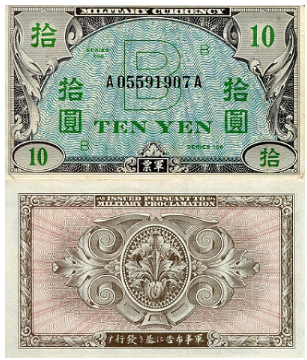 The most likely reason for their issue is based upon history repeats because human nature and its decision process will lead to the same conclusion no matter what the century. Therefore, it also remains possible that these were military scripts paid to soldiers on the front lines just as they did during World Wars I and II to pay locals. They would have reduced the need for vast amounts of precious metals on the front line or actually having US paper dollars that might have been sized by the enemy in a battle.
The most likely reason for their issue is based upon history repeats because human nature and its decision process will lead to the same conclusion no matter what the century. Therefore, it also remains possible that these were military scripts paid to soldiers on the front lines just as they did during World Wars I and II to pay locals. They would have reduced the need for vast amounts of precious metals on the front line or actually having US paper dollars that might have been sized by the enemy in a battle.
These Roman bronze issues of denarii could have served troops on the front and been redeemable for good coinage when they returned to the stable regions. Whatever the reason, many of these coins exist. They have been often viewed as possibly “coins of necessity” issued during periods of a lack of silver. Some examples may still bear traces of a very thin silver wash. It seems that they were probably military scripts since the very same practice took place in modern wars.
A “Limes Denarius” was struck from official dies. Thus, these AE denarii official issues use the same dies as those intended for the silver denarii. However, there are also some that appear to be cast from typical clay forgers’ dies and sometimes may have been cast in molds. It is possible that the opponents forged this military script version of the denarii.
There are no written accounts of this practice within the official monetary system. However, if troops are paid with real money and they lose a battle, the opponent will then seize whatever money they have and use it to fund their operations further. If the soldiers only have a military script, then there is no financial benefit to the opponent if they should defeat your troops.
Monetary Reform
Under the previous Emperor Elagabalus, his squandering of the national treasury and a further debasement of the silver coinage undermined the foundation of the Roman Empire, and his homosexual displays diminished the respect for the office of the emperor itself. Severus Alexander came to power upon the assassination of Elagabalus. The undermining of the silver coinage had begun with Caracalla’s introduction of the double denarius (Antoninianus) followed by debasement to the point that when Alexander ascended the throne, the question of the silver coinage complicated by Elagabalus’ demand that taxes were payable EXCLUSIVELY in gold, left the silver portion of the monetary system is disarray. The debasement came as a result of squandering the national treasury. Caracalla had commissioned two magnificent ships at Lake Nemi, 19 miles south of Rome, that rivaled the greatest extravagance of the Egyptian dynasties.
When Alexander came to power, initially, the debasement continued as the silver content of the denarius declined to about 2.18 grams, and in the later years, it rose to 3.9 grams. He sought to reestablish confidence in the monetary system, and he celebrates here on this bronze Dupondius. His monetary reform was intended to restore the beleaguered reputation of imperial money by improving the denarius silver content and weight in addition to striking the first substantial numbers of brass Sestertii and the copper As in over a generation.
Moreover, Severus Alexander also reduced taxes to 1/30th of his predecessor Elagabalus. He introduced the half-denomination gold quinarius to help facilitate paying taxes and sought to restore the predominantly agrarian economy. Later, after a period of peace, Celts invaded from Gaul, threatening the Empire. Severus Alexander knew the expense of war, and he attempted to buy them off instead of engaging in a costly battle. This ultimately angered the legionnaires who then elevated General Maximinus as emperor. The military rebelled, and Alexander Severus was overthrown.
Monetary System
Mints: Rome
Obverse Legends:
IMP ALEXANDER PIVS AVG
IMP C M AVR SEV ALEXAND AVG
IMP CAES M AVR SEV ALEXANDER AVG
IMP SEV ALEXAND AVG
IMP SEV ALEXANDER AVG
As Caesar
DENOMINATIONS
AU Aureus (6.54 grams)
AR Denarius
Æ Sestertius
Æ As
NOTE: Examples of Severus Alexander as Caesar are exceptionally rare. They are valued at least 10x that of Augustus.
Æ Tetradrachm (Egypt)
As Augustus
DENOMINATIONS
AU Aureus (6.54 grams)
AU Quinarius
AR Antoninianus
AR Denarius
AR Quinarius
Æ Sestertius
Æ Dupondius
Æ As
EGYPT
Æ Tetradrachm (Egypt)
BARBAROUS IMITATIONS
Monuments
Monumental Coinage of Severus Alexander
- AU Aureus (Nymphaeum)(Thermae of Alexander)
- AR Denarius (Nymphaeum)(Thermae of Alexander)
- AU Aureus (Colosseum‘s reopening)
- AR Denarius (Colosseum‘s reopening)
- Æ Sestertius (Colosseum‘s reopening)
- Æ Sestertius (Temple of Jupiter with courtyard)
NOTE: It has been argued by Hill that the Elagabalium of Elagabalus and the Temple of Jupiter Ultor were one and the same edifice and were situated on the northeast corner of the Palatine.
The Monetary History of the World
© Martin A. Armstrong

